Positively Hilarious
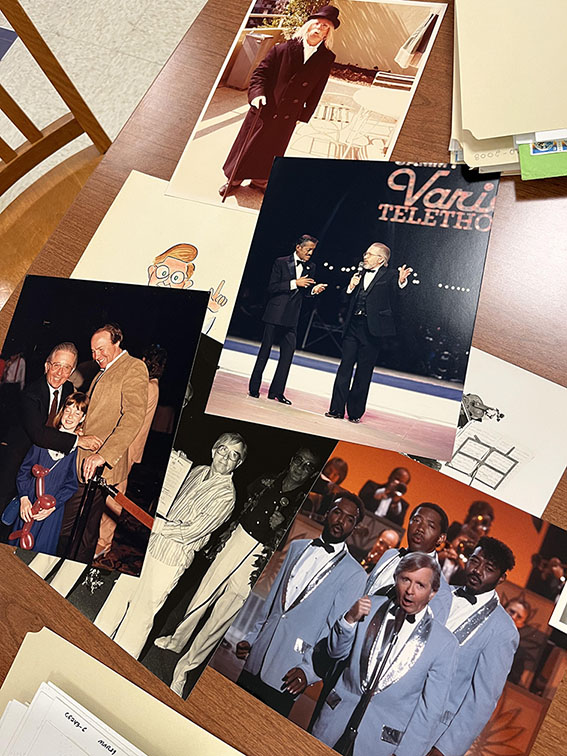
Photographs from the collection capture memories from Johnson’s career in entertainment.
___
Dig down deep for the roots of humor—and the human penchant to share it—and you’ll unearth a twining tangle of common experience, incongruity, word play, and even tragedy.
For Arte Johnson ’49 MEDIA, comedic genius arose from a desire to make laughter blossom in a positive way. Oh, and there’s also that thing about the bus.
“Chicago is made up of many ethnic islands, and people would be sitting around me and talking in their various ethnic dialects,” he once told The New York Times about riding public transport as a youth. “To me it was like music.”
Johnson would take that music and transpose it into a composition of unforgettable roles and spot-on accents—from the helmeted German soldier and park-bench skirt chaser on television’s Rowan & Martin’s Laugh-In to The Love Boat, the movies, and a variety of voices on books on tape. He entertained the world for more than half a century—from gigs in the Poconos to Emmy-worthy creations—working from the early 1950s until his retirement in 2006.
Now the University of Illinois holds the personal and professional papers of one of the iconic comic figures of the 20th century. This summer, Archives received 9.7 cubic feet of material from Johnson, who died in 2019 but always held his Alma Mater close to his heart.
A ‘Boat’-load of documents
Johnson’s contributions include 130 VHS tapes (from Laugh-In, The Love Boat, The Smurfs, commercials, movies, and talk-show appearances), signed television scripts, personal and professional photographs, autographs, and three personal scrapbooks containing newspaper clippings, photos, and correspondence from throughout Johnson’s career. There’s even a hand-written envelope from science-fiction author Ray Bradbury.
The cataloguing of materials proved especially intriguing to Sarah Harris, MS ’17 LIS, an Archives program officer, and Inbar Michael, a UI graduate student in library and information science, as the youngish people assigned the task were not exactly sure at first who Johnson was. Rather than work from their own memories of Johnson’s performances, they turned to tactics such as cross-referencing the materials with YouTube clips to figure out the context of what the tapes contained.
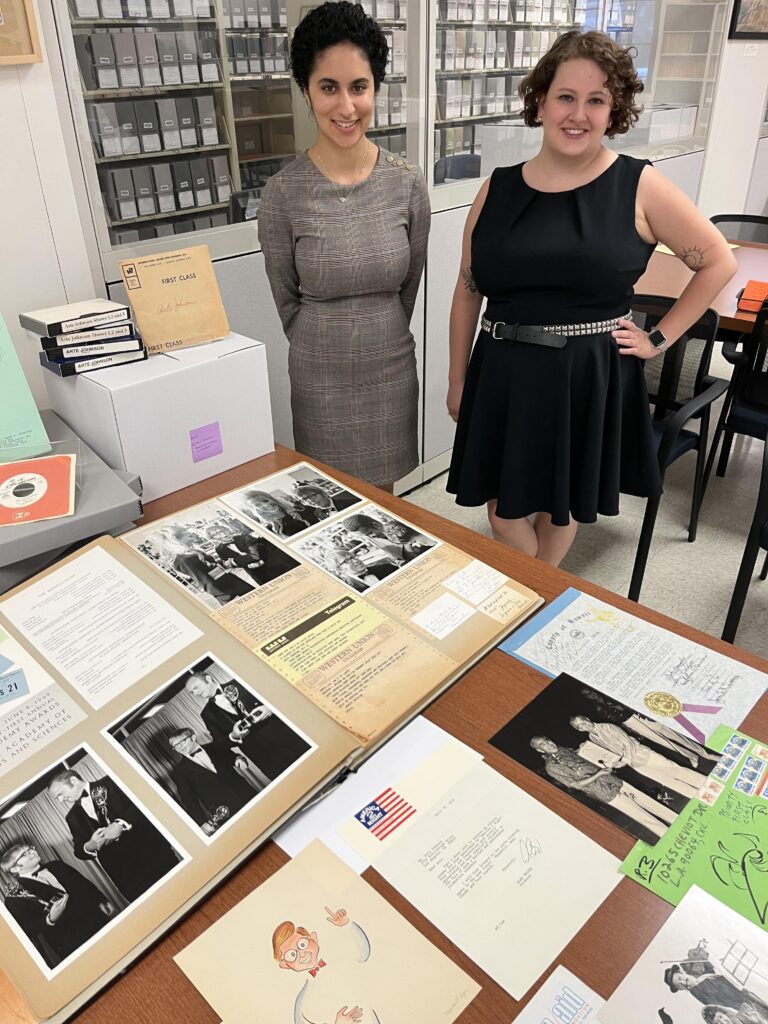
But Harris, 31, a self-avowed aficionado of television and movies, says she loves the fact that the type of material contained in Johnson’s donation is getting attention.
“I think the arts are so important in society as a whole,” she said, “and I think it deserves as much respect as anything else in [these Archives] does. First and foremost, [Archives’] charge in life is to document the history of the university. . . . But at the same time, these materials from artists and comedians . . . also show the history of the university and what the university can bring to culture. And I think that’s really special.”
“Given his impact in the ’60s and ’70s, I think it’s important for that to be preserved,” the 22-year-old Michael said of Johnson’s donation. “I’m sure that [comedy] has its place within history, and people might be looking for that as something very important [in that time period].”
Hereditary Humor
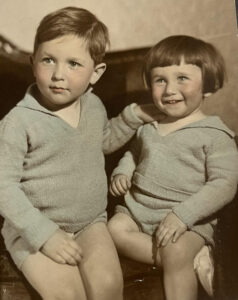
Seems Arte wasn’t the only one with a funny bone in the Johnson family. Younger brother Coslough ’52 MEDIA also graduated from Illinois with a journalism degree, joined the world of show biz (as a producer and comedy writer), and won an Emmy for his efforts. In 1994, the prolific Coslough donated to the University Library 62 scripts from the first four seasons of Laugh-In, as well as 175 scripts from several other television variety series of the seventies. The funnyman passed away in March at
age 91.
Comedy chaos
If comedy is a mash-up of incongruities, the same might be said of Johnson’s life. Entering the university at age 16, Arte (pronounced “ART-ee”) flunked a reporting class but graduated in journalism. His well-known comic character, Laugh-In’s German soldier, was already in place before he met Gisela, his German-born wife (though he later named him after her brother Wolfgang). Johnson juggled the glitz of Hollywood with a quieter personal life, owning thousands of books and enjoying a nearly 52-year marriage. And rather than yearn for years to jump-start a theatrical career, he broke into show business on a whim one day after lunch.
Returning to his lackluster job at New York City’s Viking Press, “he saw this long line on Broadway,” Gisela (pronounced “GE-seh-lah”) recounted. Discovering it was a casting call for Gentlemen Prefer Blondes, the young Johnson charmed his way to the front of the line, auditioned, and ended up with a small part as a 65-year-old man. By the mid-1950s, he had moved to Los Angeles, where his big break came with his time on Laugh-In from 1968 to 1971.
The show, which some consider a forerunner to today’s Saturday Night Live with its irreverent tone, madcap nature, and resident acting troupe, made Johnson’s reputation. With a talented cast that included Lily Tomlin, Goldie Hawn, and Ruth Buzzi, no other player harnessed a broader scope of zany characters than Johnson. Among his creations were Wolfgang (and his trademark comment, “verrry interesting”); the risqué Tyrone F. Horneigh (his favorite, according to Gisela); Indian guru Rabbi Shankar; and a silent man who constantly fell off a tricycle.
“It was really kind of pure and wonderful,” Gisela said of Laugh-In. “You laughed belly laughs. . . . So I think it’s a wonderful collection you have there from Arte.”
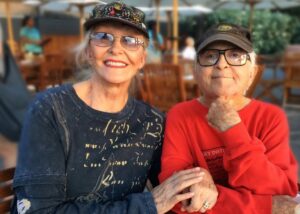
Gisela and Arte celebrating their 50th wedding anniversary at the Mauna Kea Hotel in Hawaii
Love in the time of comedy
While Arte maintained a public profile known to many, he was unfamiliar to his future wife when they met in 1968. “I didn’t own a television set,” she said and was ignorant of his Laugh-In fame.
Gisela had emigrated to California in 1961 after surviving in Bremen, Germany, during World War II. As a 5-year-old in 1944, she and her family were buried alive for 26 hours in their home following an Allied bombing raid; for 10 years thereafter, the five of them lived in a one-room garden shack in Wildeshausen. American military personnel were stationed close by, and the family would trade eggs for cigarettes, which Gisela’s father then bartered for food from local farmers. “That was when for the first time I got an orange” she said of her interactions with the Americans. “I knew when I grew up [that] I wanted to come to California where the oranges are.”
But adjusting to life in the U.S. wasn’t easy. By 1968, she had decided to permanently return to Germany that May. But in January, her friends convinced her to come to a charity event on Sunset Boulevard, where she met Arte. “Where do you come from?” he inquired upon seeing her. In an antisocial mood, she replied, “I come from the moon” (words that would later be inscribed in Arte’s wedding ring).
But Arte persisted, and their first date in February lasted hours. “We talked about music, politics, art, travel, everything,” Gisela said. A month later, they were engaged. By August, they had married.
Over the course of their marriage, Gisela accompanied Arte to all of his work sites and to the Illinois campus—“his pride and joy,” she said. And while Arte may have failed his academic reporting class, he did spend a goodly amount of time in the Main Library, as he lovingly recalled in a Winter 1979-80 issue of Friendscript:
Now, I’ve been called many things in my life, but “bibliophile” is the one term I appreciate most. Through the years I have fortunately found myself in a position to acquire a fine library and to visit some of the world’s finest as well. I’ve seen the Book of Kells in the library at Trinity College in Dublin, and an original Gutenberg Bible at the Museum of Printing in Mainz, Germany. I’ve visited the Bodleian Library at Oxford; I’ve been to the library at UCLA, the Folger in Washington, and in the stacks at the Library of Congress—to name just a few. But, of all the libraries I’ve visited and seen, the Library at the University of Illinois remains most firmly impressed on my memory. In my dreams, I can still see myself walk up those marble stairs and, being a creature of habit, turning to the right and finding a table in that corner just in front of the bound copies of Life and not far from the Saturday Review of Literature. I learned and I enjoyed. The Library was for me at once a place to escape to, a place of enlightenment, a place of encouragement.
Despite his showbiz schedule, Johnson never forgot the Library and remained a longtime supporter. And woven throughout the complex of interests that defined him—from Laugh-In to libraries—ran the thread of Johnson’s essence: his genial outlook. As Gisela put it, “Arte always made sure in his acting—you gotta be positive.
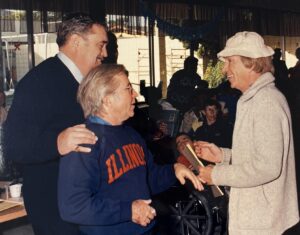
“Arte always said, ‘If you smile at somebody, the smile comes back.’ And that is really the mantra.”
No doubt quite true. As Arte himself might have surmised, a “verrry interesting” mantra indeed.


